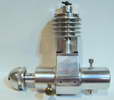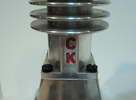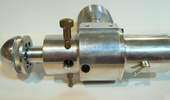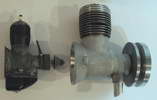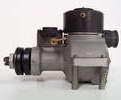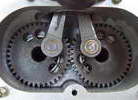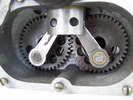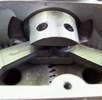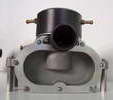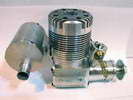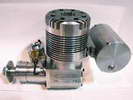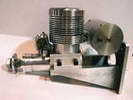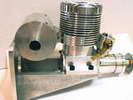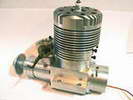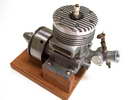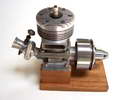|
|
This four stroke gear driven drum valve engine made in England. It was obtained by Darrel in 1981 while he was living in there. It is believed to have been a submission to the annual engineering exhibition event held in the UK, but this is unconfirmed. The trusses that distribute the stud clamping forces look very steam-driven to me for some reason...
|
|
|
This is a Kemmerling 9.6cc compression ignition engine obtained by Darrel in 1994. The story goes that these engines were made post WWII from top quality aluminum salvaged from the prop hubs of the famous Messerschmitt aircraft, resulting in a strong "Bar Stock" engine with great history. It was designed as an aircraft engine and 2 other sizes are also known to exist: a 5cc and a 3.5 cc all from 1948. Only small production runs have been documented. Note the unusual mounting holes, venturi, and the neat compression screw lock.
|
|
|
Darrel obtained this unusual engine in England during the early 1970�s. From what Darrel and his friend, Peter Fisher were able to determine, the engine was made in Exeter, England, however no mention of the maker was ever found. Three other examples of this unique engine have been seen, although all had broken crankshafts. The engine is about 0.60 cuin or 10cc, having a bore of 1.00" and stroke of 0.75". As seen in the last photo, it bears a visual resemblence to the US made Arden 0.199 cuin, although much larger. Write us if you can add any more details.
|
|
|
This is a Russian made marine engine with No Name. Only ten were made and all were acquired by Miguel deRancougne for use as "trade items"; Darrel has two. The obvious feature is the geared, contra-rotating crankshafts for contra-rotating water-screws. Using two conrods (with offset wristpins) should balance out piston side forces, giving a slight friction reduction. Less obvious is the way the conrods are themselves geared together at the little-end (look closely at the lower middle shot). Now think of cutting those gears so the parallelogram formed by the four meshed gears precisely matches the pivot locations dictated by the case, cylinder, and piston geometry. By no means impossible, but rather strict precision is required.
|
|
|
These engine were made by Dick Morris in the 1970's. There are three similar, but different bar-stock engines here: tow glow ignition and one for spark (look closely to see the little differences in the two glow plug versions). If they look big, they were! The displacement is 1.20 cuin and were designed as protypes for commercial products. He was told that 1.2 was way too big and no modeller would ever want such a thing. Dick sure was ahead of his time on this one.
|
|
|
This is a Hell Razor 90 built for marine use by Max Biederman and Art Hasselbach. As noted in Tim Dannel's American Model Engine Encyclopedia and Anderson's Blue Book, there was also a .60 of this name with a similar appearance. Both references state that there were other models as well, with the Blue Book mentioning the .90 and a .499 cuin version, but neither have pictures. Darrel believes that the one pictured here represents the first published photo of the 90.
|






